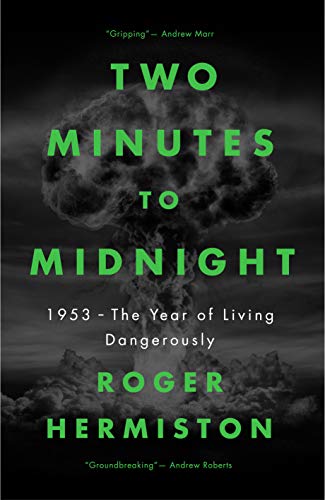
Finest Hour 193
Books, Arts, & Curiosities – Time Bomb

January 9, 2022
Finest Hour 193, Third Quarter 2021
Page 47
Review by Kevin Ruane
Kevin Ruane is Professor of Modern History at Canterbury Christ Church University and author of Churchill and the Bomb in War and Cold War (2016).
Roger Hermiston, Two Minutes to Midnight: 1953, the Year of Living Dangerously, Biteback, 2021, 352 pages, $29.95/£15.05. ISBN 978–1785906541
In 1947, two years after the atomic bombing of Japan, and coinciding with the onset of the Cold War, the Bulletin of the Atomic Scientists made its first appearance. The eminent American physicists behind the bulletin decided that its cover logo should be a clock that would be set at a certain number of minutes to midnight. The intention was to give readers an ongoing visual indicator of how close the world was to catastrophe—to the midnight chime—now that the basic power of nature had been harnessed in a weapon of mass destruction.
On début, the Doomsday clock, as it became popularly known, was set at seven minutes to Armageddon. In 1949, when the Soviet Union joined America as an A-bomb power, the clock inched forward four vital minutes. The closest the clock came to midnight during the remainder of the Cold War was not, as might be supposed, in reaction to the 1962 Cuban missile crisis, but in 1953. It is this reset that gives Roger Hermiston the title of his riveting book, Two Minutes to Midnight: 1953, the Year of Living Dangerously. Winston Churchill, who returned as British prime minister in 1951, is accorded a leading role in the narrative.

2024 International Churchill Conference
Hermiston sets out to rescue 1953 from its status in popular memory as “one of the ‘monochrome’ years in the early Cold War” and succeeds admirably in a lively account that blends Cold War history with American and British domestic events and trans-Atlantic popular culture. Anyone reading this book will be puzzled that 1953 ever went monochrome given its technicolour content: this was the year of Watson, Crick, and DNA; of the Coronation in Britain which formally opened the second Elizabethan Age; and of Burt Lancaster and Deborah Kerr embracing in the surf in From Here to Eternity. It was also the year when an eighteen-year-old Elvis Presley wandered into the Sun Records recording studio in Memphis, Tennessee, to “change the world’s popular music scene, and with it youth culture, for ever.”
Fascinating as these moments are, it is nonetheless the mainframe of the Cold War that is Hermiston’s predominant concern in 1953, be it the death of Stalin, the end of the Korean War, or the CIA-sponsored coup that put the Shah of Iran back on the peacock throne. And then there was the principal reason for the Doomsday clock’s unnerving lurch forward—the hydrogen bomb, a weapon with a destructive power that dwarfed its atomic forerunner, a veritable “city killer.” In August 1953, the Soviet Union announced that it had won the H-bomb race, but we now know that the United States got there first; in November 1952, the Ivy-Mike test in the Pacific was the world’s first thermo-nuclear blast, though it would be 1954 before the United States possessed deliverable H-bombs.
In between the times, the Soviet Union seemed to have stolen a truly frightening technological march on its Cold War rivals. But Hermiston’s 1953 is also the story of Churchill’s response to thermo-nuclear advances. Even before returning to power in 1951, Churchill, worried about the dangers posed by atomic weapons, had spoken publicly of the need for an East-West “summit” to prevent Cold War from becoming Hot War. The Soviet H-bomb turned this aspiration into an objective, even an obsession. In 1953, when Stalin’s successors expressed interest in easing Cold War tensions, Churchill sensed an opportunity to bring about a summit, only to be blocked by US President Eisenhower, who saw only a Kremlin ruse to make NATO drop its guard. Considerable mutual Winston–Ike irritation ensued.
Hermiston also shows how Churchill’s conviction that he was pre-destined to be a Cold War peacemaker contributed to his recovery from the stroke that felled him in mid-1953. Churchill’s physical restoration was remarkable, but it was intimately connected to a psychologically-sustaining vision of a “big men” summit at which he would help put the world to rights. Churchill’s vision would go unrealized during what remained of his premiership, and Hermiston’s account ends with the Western (US, UK, and French) leaders gathering at Bermuda in December 1953, where Eisenhower told his allies that nuclear weapons henceforward were “to be treated just as another weapon in the arsenal.” For Churchill, it was confirmation of how far apart America and Britain were in their nuclear attitudes.
The Doomsday clock continues to tick. In 2018, it was set at two minutes to midnight for the first time since 1953, and then in 2020 it moved to 100 seconds to midnight, the nearest it has ever been to the trigger moment. Today, climate change is weighed alongside nuclear weapons as a real and present danger to the planet. Back in 1953, as Roger Hermiston demonstrates in this accessible, lucid, and absorbing book, it was the H-bomb alone that caused Churchill, and many other people, the greatest anxiety.
Subscribe
WANT MORE?
Get the Churchill Bulletin delivered to your inbox once a month.


